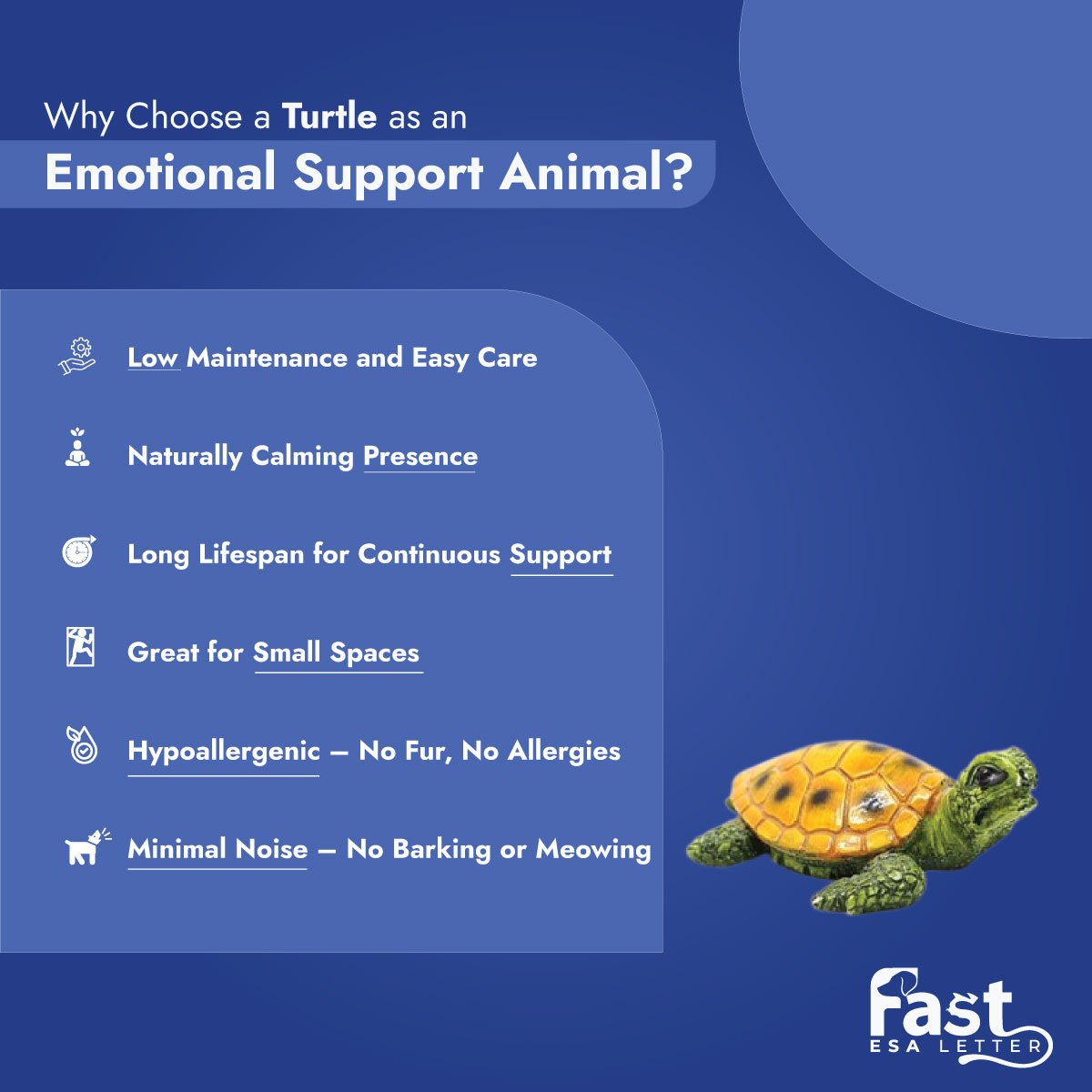Can a Turtle Be an Emotional Support Animal? Yes—Here’s How!

Robert Clendenin, MD
When you think of an emotional support animal (ESA), a dog or a cat probably comes to mind. But what if we told you that a turtle emotional support animal could be just as beneficial—if not better—for certain individuals?
Unlike energetic pets that demand constant attention, emotional support turtles provide a soothing presence without overwhelming their owners. Their slow movements, quiet nature, and long lifespan make them an ideal choice for people seeking comfort without high maintenance.
But can turtles be emotional support animals in the eyes of the law? And how do you get your emotional support turtle recognized? Let’s explore everything you need to know.

Can a Turtle Be an Emotional Support Animal?
A turtle emotional support animal is legally recognized when accompanied by a valid ESA letter from a licensed mental health professional. This letter grants certain rights, such as housing protections under the Fair Housing Act (FHA).
Why Choose a Turtle as an Emotional Support Animal?

- Low Maintenance and Easy Care
- Emotional support turtles don’t require constant attention, making them ideal for busy individuals.
- They don’t need daily walks or social interaction like dogs or cats.
- A properly maintained tank with food, water, and warmth keeps them happy.
- Naturally Calming Presence
- Watching a turtle swim can be incredibly soothing and stress-relieving.
- Their slow-paced movements encourage mindfulness and relaxation.
- Perfect for people who need a quiet, peaceful ESA without excessive energy.
- Long Lifespan for Continuous Support
- Turtles can live 20-100 years, making them a long-term companion.
- You won’t have to go through the heartbreak of losing your ESA after a few years.
- Great for Small Spaces
- If you live in an apartment or dorm, a turtle emotional support animal is ideal.
- They require minimal space compared to larger ESAs like dogs.
- Hypoallergenic – No Fur, No Allergies!
- Many ESA owners suffer from pet allergies—turtles don’t shed fur or dander.
- They are perfect for people who need an ESA but can’t tolerate allergens.
- Minimal Noise – No Barking or Meowing
- Unlike dogs or birds, turtles don’t make disruptive noises.
- Perfect for individuals sensitive to loud sounds or those who prefer a quiet home.
How to Make Your Turtle an Emotional Support Animal?
If you want to designate your turtle as an emotional support animal, follow these simple steps through the Fast ESA Letter process:
Step 1: Schedule an Appointment
Begin by creating an account on the Fast ESA Letter platform and booking a consultation with a licensed mental health professional (LMHP).
Step 2: Consultation with an Expert
Engage in a video or phone consultation with the LMHP, who will evaluate your mental health needs and determine if a turtle emotional support animal is a suitable option for you.
Step 3: Receive Your ESA Letter
If approved, your official ESA letter will be sent to you via email. This document grants you the right to keep your emotional support turtle in housing that typically restricts pets. Fast ESA Letter simplifies the process, ensuring a smooth and efficient way to obtain legal recognition for your ESA without unnecessary delays.
What Laws Protect Emotional Support Turtles?
The Fair Housing Act (FHA) is the primary law that protects individuals with emotional support turtles. Under the FHA, landlords and housing providers must make reasonable accommodations for ESA owners, even if their property has a no-pet policy. This means that with a valid ESA letter, tenants can live with their turtle emotional support animal without being denied housing or charged additional pet fees.
Unlike service animals, emotional support animals are not granted the same public access rights, meaning your emotional support turtle cannot accompany their owners into public places like restaurants or stores. Additionally, when it comes to air travel, most airlines only allow dogs and cats as ESAs. However, some may accommodate turtles under specific conditions, so it’s always best to check with the airline before flying.
What is the Cost of Owning an Emotional Support Turtle?
While emotional support turtles are more affordable than dogs or cats, there are still costs involved in their care. The initial setup, including a proper tank, heating elements, and filtration systems, can be expensive, but once established, maintenance costs remain relatively low.
A turtle emotional support animal requires a high-quality tank with heating and lighting equipment, costing around $100 to $300 initially. Monthly expenses, such as food, water filtration, and supplements, typically range from $20 to $50.
Veterinary checkups, while infrequent, can cost around $50 to $100 per visit, ensuring your turtle remains healthy. While the upfront costs may seem high, turtles have a long lifespan, making them a cost-effective ESA option in the long run.
What are the Disadvantages of Having an Emotional Support Turtle?
- Limited Emotional Interaction: Unlike dogs or cats, turtles don’t show affection in the traditional sense. They don’t cuddle, wag their tails, or seek attention, which can be disappointing for owners looking for a more interactive ESA.
- Housing Restrictions: While the FHA protects ESAs, some landlords may still hesitate to allow reptiles. You may need to educate them on ESA laws and provide proper documentation.
- Strict Care Requirements: Turtles require specific temperature, humidity, and water conditions to stay healthy. Maintaining their environment takes dedication.
- Travel Limitations: Many airlines do not allow turtles in the cabin, making it challenging for frequent travelers who rely on their ESA.
- Long-Term Commitment: A turtle’s lifespan can range from 20 to 100 years, meaning you need to be prepared for a long-term responsibility.
What are the Best Breeds of Emotional Support Turtles?
- Red-Eared Slider: One of the most popular turtle species, known for being social and interactive.
- Eastern Box Turtle: Low-maintenance and perfect for first-time turtle owners.
- Painted Turtle: Active swimmers that bring visual relaxation.
- Russian Tortoise: Hardy, adaptable, and easy to care for.
- Mississippi Map Turtle: A playful breed that enjoys human interaction.

Conclusion
If you’re considering a turtle emotional support animal, make sure to obtain a valid ESA letter to access housing accommodations and other legal protections.
Looking for an easy way to get your ESA letter? We can help you through the process quickly and legally!
Frequently Asked Questions (FAQs)
How Do I Qualify For An Emotional Support Turtle?
Can Turtles Be Used For Emotional Support In Apartments With No-Pet Policies?
Yes! With a valid ESA letter, landlords must accommodate your emotional support animal turtle under the Fair Housing Act, even in pet-restricted housing. However, tenants are still responsible for ensuring their ESA turtle is well cared for and does not cause property damage.
Can Turtles Help With Anxiety And Depression?
Can You Bring Turtles On A Plane As An Emotional Support Animal?
Do Emotional Support Turtles Require Special Training?
Do Emotional Support Turtles Need Vet Checkups?
Are Therapy Turtles And Emotional Support Turtles The Same?
Post Author
Prince Sharma
Related Articles
Can a Bird Be An Emotional Support Animal?
Can a Bird Be An Emotional Support Animal?Yes, a bird can be your emotional support animal (ESA). These feathered friends offer incredible comfort and emotional support. There’s no need for special training. A ESA letter from a licensed mental health...
Can Emotional Support Fish Improve Your Mental Health?
Can Emotional Support Fish Improve Your Mental Health?Yes, emotional support fish can improve your mental health. Observing their peaceful movements can reduce stress and anxiety.Medically Reviewed by Robert Clendenin, MDAn ESA Letter makes...
Rodents as an Emotional Support Animal
Choosing Rodents as an Emotional Support Animal.Yes, rodents can be emotional support animals. While less common than dogs or cats, rodents like guinea pigs and rats can provide emotional support and companionship, making them suitable for...
Live Free with Your ESA!
An ESA Letter Unlocks Freedom!





